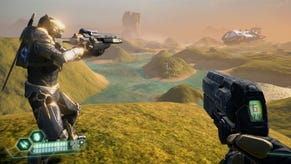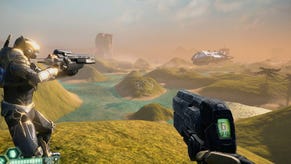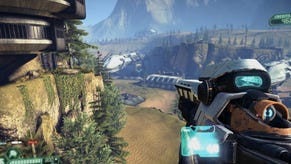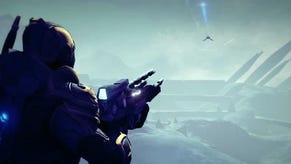Perilous Parabolas: Tribes Ascend
A Spot Of Skiing
Roving reporter Dan Griliopoulos has left Alec in Cologne and is heading deeper into Europe, writing up what the best of GamesCom as he goes. Next up is Hi-Rez Studios' Tribes reboot, Ascend.
Switzerland may have been condemned memorably by Orson Welles as having “five hundred years of democracy and peace – and what did that produce? The cuckoo clock”, but (aside from the cuckoo clock actually being a German invention – Pedant Ed) these days the most vertical of European countries is better know for its winter sports. As we rattle through its tunnels and stare up at its mountains, though, I'm thinking of a very different kind of skiing; I look at the 80 degree slopes of the Stelvio pass and think “you'd pick up so much speed on that and then you could jetpack off that glacier and...”
Hi-Rez studios, developers of Global Agenda, were showing off the latest iteration of the Tribes multiplayer jetpacking-skiing-shooting trope at GamesCom. They've certainly got the right credentials, having worked action multiplayer shooters before, and they're pretty up front about their ambition; “We wanted to keep the spirit of Tribes – the fast gameplay, the emphasis on individual skill and teamwork – but we also wanted to evolve and change some things,” says Todd Harris, CEO of Hi-Rez. “We've got fans of the old games on staff, but none of the original teams.”
Getting hands-on with the game was definitely exciting; old fans of the series will be absolutely satisfied with the key mechanic, that combination of right mouse button jetpacks and 'skiing' - that is, sliding down declining surfaces to pick up speed as you move around the world, with momentum maintained as long as you hold down the space key – and as long as it lasts. Like in previous iterations, it just works; It's not realistic, as such - “it embraces it's a game” as Harris puts it. Once you've got it down pat, the game makes the parabolic movement dynamics second nature.

The single level 'Crossfire' we played looked like a drowned golf course, with gentle curving hills rising out of a sea, with a floating battle barge at either end, with the traditional saturated, bright colours of the series. Players had to capture each other's flags from the front of each barge, in a classic capture-the-flag mode. Each barge has automated defenses and can be further fortified by the engineer class. The normal game is 16 versus 16, but due to the very limited space at GamesCom, we could only play 5v5. The game will release with four maps, including this one, which was relatively small. Despite this relatively small size, we still managed to spend a while trudging around its lakes and hillocks, having not quite got the knack of the skiing yet.
The class system has changed substantially. Where before you chose from light, medium and heavy armour, now players pick one of the fifteen classes (only nine were available in the version we played; the other six will be released each month after launch). Each class still matches those armour-classifications, but also has a special power, a grenade type, a sidearm, and a special weapon. For example, the infiltrator has can go stealthy, has standard grenades, a silenced pistol and an SMG – the first ballistic weapons to be introduced to the Tribes series. The classic Spinfuser will be employed by the standard soldier class – the only class that will be available to free players, to start with.

Players spawn in their battle-barge and accrue in-round currency (which is new) as they damage and kill enemy players, capture flags and so forth. This currency can be used to upgrade your base or buy vehicles from a podium tucked away in the battle barge; when you do, you're teleported straight into your newly built vehicle. The three vehicles we saw were the Shrike (a murderously efficient fighter / gunship), the Gravcycle (a nippy but mostly ineffectual single-person transport) and the Beowulf (a biiigg tank). Obviously, this purchasing power means the violence of the gameplay escalates significantly as a game progresses.
Similarly, you can buy more ammo or change weapons at podia inside the barge. However, should an enemy penetrate to the barge generator, they can take down both the turrets and the various podia, until a player trudges back inside to repair it. At the moment, I'd argue that the podia and generator are curiously inaccessible, relative to the ease of accessing the flag; at one point, I had to flee back to the barge, with no weapon to speak of (having run out of ammo on my sticky-grenade launcher and having replaced my sidearm with a repair tool), but was simply unable to find my way to a working ammo point.

Between matches, Hi-Rez have introduced character progression – players can earn both additional levels, such as badges that give purely aesthetic prestige, and perks that give minor in-game benefits – increasing your run speed or manoeuvrability say. Players can also unlock additional classes through playing but, knowing this model from Team Fortress and so forth, we'd estimate that the vast majority of unlocks are going to be through real-money purchases.
With real money transactions you can also buy new cosmetic skins for your classes and XP boosters, to increase your levelling rate. As I've heard Harris say many times and heard him say again here; “It's very important to us that there's no pay to win – anything that affects gameplay can be earned by just playing the game.” It's refreshing to see a company being so upfront about RMT; so many companies we met at GamesCom, including favourites like Planetside 2, were refusing to talk about how they were going to make money because they're scared that the media won't talk about their game if it's free-to-play. Tribes show that we will, if they're good enough.








